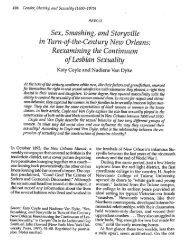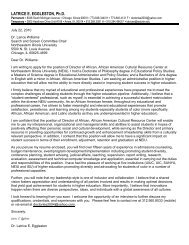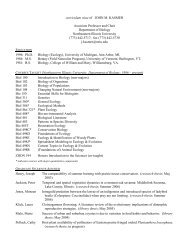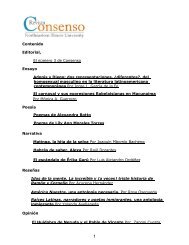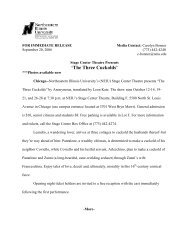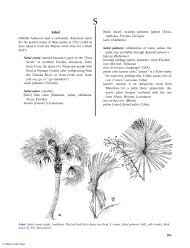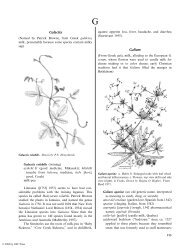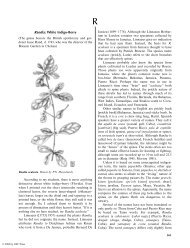Herba Cana - Northeastern Illinois University
Herba Cana - Northeastern Illinois University
Herba Cana - Northeastern Illinois University
You also want an ePaper? Increase the reach of your titles
YUMPU automatically turns print PDFs into web optimized ePapers that Google loves.
© 2004 by CRC Press<br />
The Ethnobotany 487<br />
Latin cervi spina was applied to Rhamnus by<br />
Valerius Cordus, 1514? /1544)<br />
buckroot (known by this name in 1765 when John<br />
Bartram visited the Carolinas, Berkeley and<br />
Berkeley 1982)<br />
hoary scurfpea (‘‘scurf’’ is dry, scaly skin, especially<br />
on the head; probably from Old English<br />
scurf; akin to Swedish skorv, Danish skurv,<br />
Dutch schurft, and German Schorf)<br />
owá:lá:rî: ínsawá:kî (Sturtevant wrote ‘‘prophets’<br />
[plural; singular, owá:lî] coconut,’’ Mikasuki;<br />
‘‘owá:lî’’ is also translated as ‘‘wise-man,’’ ‘‘magician,’’<br />
or in Creek, as ‘‘knower’’); owa:lâlki<br />
insawkô (owalv, knower, em, his, svokv, rattle,<br />
Creek; the ‘‘coconut,’’ Cocos nucifera, is talasvokv)<br />
These herbs are restricted to parts of Virginia,<br />
Georgia, Florida, and Alabama (Radford et al. 1968).<br />
Because of their limited range, not much has been<br />
written about them, yet the Seminoles knew and used<br />
them as late as the 1950s (Sturtevant 1955). Moreover,<br />
they were familiar with the restricted range of the<br />
plants in Florida, noting that they did not grow south<br />
of Punta Gorda. They would make special trips into<br />
the area where the plants grew to obtain stocks of the<br />
roots to dry for use in medicine. Hedrick (1919) and<br />
Yanovsky (1936) say the roots have been eaten in the<br />
southern states.<br />
According to Josie Billie, one of Sturtevant’s<br />
collaborators, these legumes were analgesic when the<br />
warmed root was applied externally. To treat rheumatism,<br />
they took a root, dipped it in water, warmed it<br />
over the fire, and then pressed it against the sore spots.<br />
They considered it strong and expected the pain to be<br />
gone by the next morning. In addition, the roots were<br />
used in a medicine to treat colds and coughs.<br />
Sturtevant (1955) gave a lengthy account of his<br />
personal experience treating his own cold, and he<br />
was convinced it helped.<br />
Neither Foster and Duke (1990) nor Duke (2002)<br />
even mention the genus Pediomelum. Under Psoralea,<br />
Hocking (1997) says that this species has been used to<br />
treat gastric distress.<br />
Peltandra<br />
(Rafinesque named this with Greek pelte, a shield and<br />
andros, stamens)<br />
Peltandra virginica (from Virginia)<br />
[green] arrow [arum] (USA)<br />
ocfô (Creek); okõ:nî (Mikasuki)<br />
Peltandra virginica. a. Habit. b. Outline of leaf. c. Spadix.<br />
d. Berry (submersed). Drawn by Vivian Frazier. From Correll<br />
and Correll 1972.<br />
Pfeilaronstab (arrow arum stick, German)<br />
takwahahk (Capt. John Smith wrote the Powhatan<br />
name as tockwhogh, tocknough, and tockawhoughe.<br />
He said that it was the ‘‘chief root<br />
they have for food ... like a flag in low muddy<br />
freshes ... of the greatness and taste of potatoes<br />
...raw it is not better than poison ...roasted ...<br />
in summer they use this ordinarily for bread.’’<br />
Strachey wrote in [1612] 1953 that it was a<br />
‘‘bread made of a wort called taccahoappoans.’’<br />
Siebert 1975 considered the root to be /*takw-/,<br />
to pound fine, beat to a powder. The word<br />
written by Strachey includes the element appoans,<br />
which became ‘‘pone’’ in English; see also<br />
Zea); cognates include takáham (Delaware);<br />
takwaham (Cree); takwahamwa (Miami); takwham<br />
(Nipmuck-Pocumtuck); taw-ho [tawho, tawhim,<br />
tawhim, tuckah] (Delaware, New Jersey);<br />
tquogh (Mohegan); tukwhah (Shawnee); nitakhwa<br />
(‘‘I pound him for bread,’’ Shawnee);<br />
otakwaʔa·n (Ojibwa)





